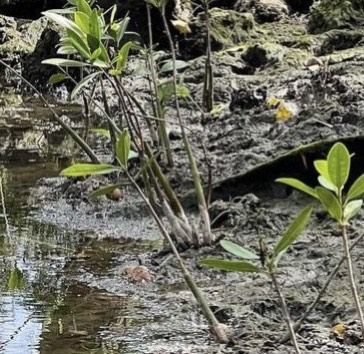The Problem
Coastal erosion, briodiversity loss, and global warming
Coastal erosion, briodiversity loss, and global warming
Regenerating mangrove forests will protect against coastal erosion, provide a home to our life-sustaining marine ecosystem, and absorb greenhouse gas emissions. You will need 4 friends, a trashbag, and sunscreen. Carefully clean away debris and plastic around mangrove roots, working slowly through each root system-the mangroves will regenerate on their own. Gather mangrove seeds floating on the water surface. Fill 8 inch pots with 5 inches of sand/potting soil mix, and cover with 1 inch of water. Plant a seed a 1/2 inch down, and place in the sunlight, keeping moist, for 3 months. Replant in intertidal water a foot above sea level in an area that will get water every day at high tide. Help regenerate a million mangroves.
Throughout the long days of the pandemic, we got outside and meticulously cleared the roots of more than 3 miles of mangroves along South Florida coastlines, and collected propagules, which are mangrove seedlings that lay on water's surface. They are pretty easy to grow, with a lot of light and water. However, regenerating mangroves by replanting is more difficult, as they have to be placed in intertidal areas where they are watered daily by high tides, but do not wash away before they take root. Natural regeneration through mangrove root clean up is the most successful way to restore these forests, which protect our coastlines, provide a home to our life-sustaining marine ecosystem, and absorb carbon. This project can be repeated and easily completed with small groups, and we are continuing to restore mangroves weekly, as well as grow new seedlings for replanting. Our goal is to restore one million of these "super trees." To do this, we need everyone. We are scaling up our project through collaboration with other organizations doing mangrove clean ups and plantings, education on how to plant mangroves in your own community, and innovation. This last part is pretty cool: we are splicing seedlings, sealing with biodegradable wax, and planting. It's working!
Mangroves are "super trees." They grow fast, and can restore themselves when their root systems are clear of human debris. They can live in fresh or saltwater, and in sand or mud (a mixture of each is perfect). They are the only tree in the world that can live in salt water, and are the planet's best natural storm barrier. Because they are fast-growing and have a large leafy covering, they are one of the best trees in the world for sequestering carbon. They provide a home to foster the bio-diversity of our life-saving marine ecosystem. Unlike other native trees which are specific to one area only, mangroves grow in coastal areas across the world.
In order to plant many mangrove seedlings that will provide coastal protection, interdial areas need to be properly restored first if the sand has eroded, so that the young plants take root. Next up we will be working with the City of Miami and the City of Miami-Beach to restore larger areas, in conjunction with coastal engineers. If your City is not able to undertake coastal engineering, there are still two vital parts of this project you can undertake: 1) carefully remove plastics and other human debris from mangrove root systems, and 2) petition your local government for greater enforcement laws against destructing mangroves.
Working outside, working with friends, and saving the planet. Mangrove restoration is a rewarding solution to the climate emergency, because it is a solution that is both an adaptation and mitigation.
If you are growing mangroves, feel free to go overboard on water and sunlight. You can keep the sand/mud mixture covered in water, and keep the small pots in a bright spot, though keeping them out of direct light where they get too warm is best. Soak the mangrove seedlings in fresh water for 24 hours before you plant them in small pots.


